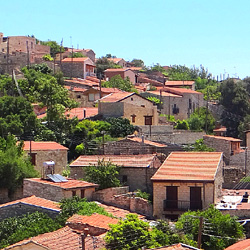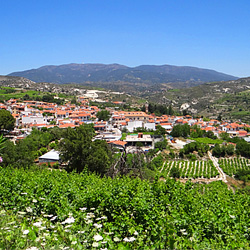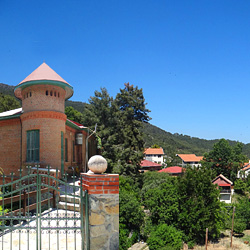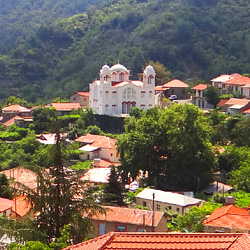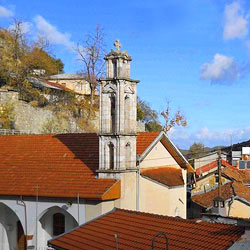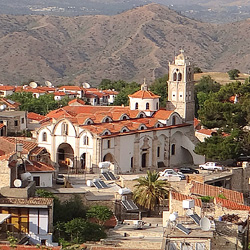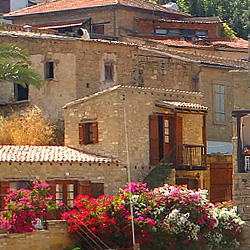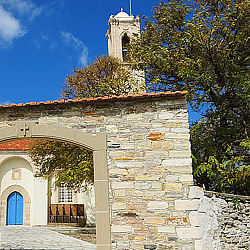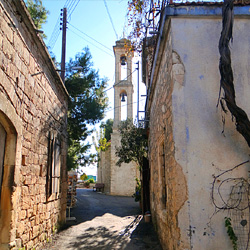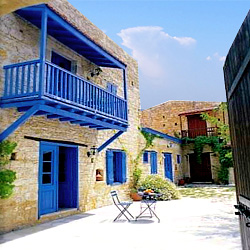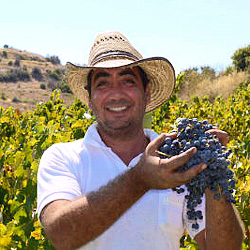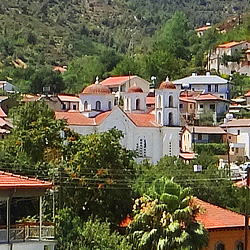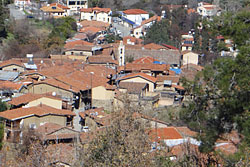
Old Kakopetria
Palia Kakopetria (the old part of the village) is the most beautiful and picturesque part of the village and it is built on the place where Kakopetria had first arisen (Old Village). Today, this part of the village is actually on the west side of the village, and more specifically it emerges from the left side of the valley Solia. Palia Kakopetria is surrounded by two rivers: Karkotis and Garilis.
The architecture of Palia Kakopetria will attract and amaze you with its distinct character. The houses are all built very close to each other and almost all of them have two floors. The roofs of the houses seem to be united as a big imaginable road.
The little houses have sloping and tiled roofs which are based on wooden beams. Each house has a beautiful wooden balcony which gives a magic color to the image of the village. They are made of adobes and big stones found in the rivers of the village.
The first floor of each house was used as a warehouse where they kept big clay-jars full of wine or other foods but also the people who had animals used to put them there. The families lived usually on the first floor, which in the Cypriot dialect was called “anoyi” or “makrinari”.
Every house had a little yard where they usually kept logs which were used in the mud-oven and in the “tsiminia” which is something similar to the fireplace.
Among the traditional and picturesque houses of Kakopetria lies a tortuous stone made road. Within the efforts for the embellishment of Palia Kakopetria, a sewage system was put below the stone made road.
The traditional architecture and building of the houses offer to the village a special color. The entire village is a unique sample of original folk architecture.
The inhabitants of the village have contributed to the conservation of the folk architecture of the village as they began restoring their houses on their own but also according to the guidelines of the Department of Antiquities. The first houses were restored in 1980.
Both the participation of the inhabitants of Kakopetria and the governmental services have ensured the renaissance of the traditional architecture of the village. Palia Kakopetria is under the protection of the Department of Antiquities and it is classified as an ancient monument.
After the classification of Kakopetria by the Department of Antiquities as an ancient monument, more restorations have begun. For example an old wine press and a watermill were repaired.
Palia Kakopetria is a vivid museum of folk tradition and architecture and offers to every visitor amazing landscapes and many elements of the Cypriot civilization.
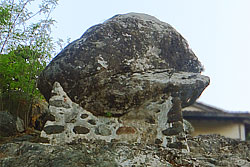
Petra tou Antrogynou
The “Petra tou Antrogynou” (stone of the married couple) is situated in the entrance of Palia Kakopetria, near the upgrade road that leads to the church of Transfiguration.
There are many traditions related to the “Petra tou Antrogynou”. Each couple after their wedding they went to the big stone where a special ceremony took place.
First of all, the couple should walk around the stone and then sit on it. Then, all the friends of the couple congratulated them and wished them to have a happy marriage.
Another version of the custom says that the couple just sat on the stone so that their marriage would be very happy.
These traditions give an excellent explanation to the name of the stone, and they offer a special “scent” to the customs of Kakopetria.
On the other hand the “Petra tou Antrogynou” is related with an unpleasant event, which took place in the village. After one wedding ceremony, a couple went to the stone in order to realize the above custom. Unfortunately the stone started to move and crushed a couple of the guests.
Another tradition says that the village “Kakopetria”, which in Greek means bad stone, was given after the unpleasant story that took place at the “Petra tou Antrogynou”.
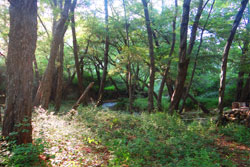
Kakopetria Forest
Dominating pine-trees, platan-trees and poplars prevail in the green scenery, in contrast to acacias and oak trees which only constitute minor “brushworks” of this idyllic picture. This “image of natural vegetation” is completed, as Karouzis characteristically remarks, by “wild olive trees, Cistaceae and other types of wild vegetation”.
Cultivated at the village are several fruit-baring trees such as apple, pear, plum, cherry trees, apricot and fig trees, as well as vegetables. Particularly recognized are the apples produced in Kakopetria known as “kakopetritika”, the naming of which derives from their place of production.
Also distinguished, as Karouzis distinctively describes, is the “abundance of grape pergolas, which can either be found above the verandas of the houses or in the small broken fields. These pergolas supply the residents and the market of Lefkosia with late “veriko” type grapes”.
Kakopetria is ideal for nature lovers since, apart from the green beauties, the village maintains the “Trail of Atalanti” which begins from the location “Chromio” and ends at the “Troodos Square”.
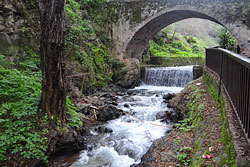
River Clarios
A green veil created with nature’s most beautiful colours covers the village of Kakopetria. Pieces of land covered with wild vegetation mingle with cultivated pieces of land creating a magical scenery.
This idyllic image of the village is completed by the two side-rivers of the River Clarios which are united in the heart of Kakopetria, freely giving their water to the village. Kakopetria constantly enjoys the sound of the streams which create a sweet melody which in turn provides peace and quiet.
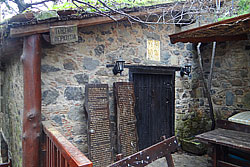
Watermills
For this famous watermill there are also some other documents. The mill was built by a deacon of Saint Nicholas monastery in 1754. The documents which were found agree that this mill belonged to the Archbishop and then it was rented to others. Some time later, the archbishop decided to sell it. Information that we have, claims that the Archbishop sold it for three hundred pounds and another one says that five other people bought it together, for two hundred and fifty pounds.
After the cesation of its operations, the “Milos tis Gonias” was restored, in 1980. The mill of Hadjistavros was demolished. The first one is nowadays a tourist sight and its present owner is Aristeidis Papa.
The people who visit the Mill can learn some basic things on its operation and the history of the mills in Cyprus. When you enter the premises of the mill you will see a rectangular wooden tub, which is narrower at the bottom. In this tub they used to put cereals, wheat and barley. On the millstone they used to place a special lever which grinded the cereals in small or coarse grains.
On the millstones there was an axle, sometimes wooden and sometimes iron made. The axle began its operation when the water entered in the water wheel. The water begun its course in the headrace, then it continued in a wooden channel and then after a vertical fall it entered in a special water hole, which is built on the side of the water wheel. After this course, the force of the water caused the operation of the millstones.
Through the description of the Mills, we can see that the inhabitants of Kakopetria exploited perfectly the water of the village. We can also discover the cultural and historical side of the village.
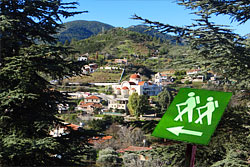
Nature Trails
The Forestry Department has created a number of trails carefully designed to cover areas of rich natural vegetation and cultural interest. They have been landscaped on gentle gradients and are, as a rule, circular so that all age groups can easily use them.
In many cases, there are signposts in place, to indicate the starting point of the trail, as well as flora and geology features along the route. Although walking in Cyprus can be enjoyed throughout the year, the recommended seasons are during late Autumn (November) and spring, when the Cyprus rural and forest areas are at full bloom.
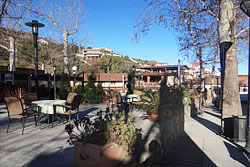
Central Square
The beautiful central square of Kakopetria with the tall plane trees and coffee shops, where you can try the traditional homemade sweets of the area and you can sit round the fireplace during the winter . The square it's just a few minutes away from the old quarter of the village which is a listed area with cobbled streets where old houses have been carefully restored or reconstructed.
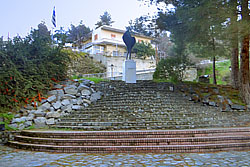
Heroes' Monument
The heroes’ monument of Kakopetria is dedicated to all the inhabitants of the village who fought for their country during the national war of independence in 1955-59.
The community in cooperation with the committee which is responsible for this kind of monument, has paid all the expenses for the construction.
On the monument you can see the goddess Niki (Victory). The unveiling of the monument took place on 27 June 1993 by the ex president of Cyprus, Glafkos Kliridis.
The figures of Alekos Kostantinou and Panayiotis Toumazou were added on the monument on 29/05/2005. The first hero was born in Kakopetria and the second one died in the village. The monument was realized thanks to the contribution of the Board of the Historical Memory for the EOKA fighters.
By building this monument, the community of Kakopetria honors the memory of all the heroes who died for their country.
- 1
- 2

